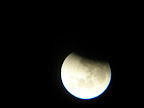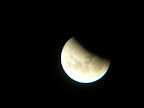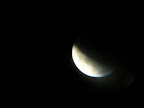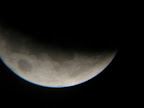 |
 |
 |
 |
 |
Now I'd tried before (March 2007) taking some pictures with a telescope and digital camera of a lunar eclipse. This was a very Heath Robinson setup. The telescope is a very basic reflector that I'd borrowed. The camera was a standard point and shoot digital, hand held up to the eyepiece of the telescope. I was actually very pleased with the results given it was a spur of the moment thing. I worked pretty well until the eclipsing happened too much, then the light levels fell, and I couldn't hold the camera still enough to take anything reasonable without a lot of camera shake and the camera waving a red handed blurring gonna happen sort of icon at me.
So - given the very basic nature of the setup it looked like things were possible.
Having got the telescope out again now the nights are getting darker and more accessible, I thought I'd have another go. Bad news, the moon is not visible from my garden, and waning fast. However there are some other things to take photos of. Mars is very prominent right now, and I had a go at taking a photo of that.
No chance, wobblesville Arizona, population you... Pressing the shutter button it was a good 2-3 seconds before the click finished, and there was just a blurred mess.
Well OK, it was probably a silly idea, I should wait for the moon again perhaps.
However flicking through some astronomy web sites and shops, wondering idly how much it would be to buy a 'scope of my own, and what do you get for your money I spotted some interesting bits on astrophotography.
For not very much money (well £20 or so) you can get a metal gizmo that sits on the eyepiece and has a couple of metal bits sticking out that allow you to screw the cameras tripod adaptor into, and suddenly the telescope and camera move as one! See the attached - if I had two cameras you could even see the camera in situ.
This was much easier to work with. You can even use the LCD display instead of the view finder. The only issue is that in the dark, without the camera attached, you stand a fairly reasonable chance of poking your eye out with the protruding metal spike - but hey, its a small price to pay.
A clear night arrived, and I had a play around. The results were not altogether as good as I had hoped, but at least there were results.
| Mars | Mars again |
| Somewhere in Orion, or maybe the Pleiades | Another Mars |
Well - the results are not stellar (groan) but they are at least there.
Then I had the good fortune to notice that the Nottingham Astronomy Society were having a talk by a visiting speaker titled "Digital Astrophotography for Dummies" by Kevin Kilburn. I could perhaps pick up a few tips, perhaps join the society, get to use their 24inch reflector. At the very least I could find out if I was on the right lines. So off to check it out, on a cold, very wet night to see if Kevin has any tips I might use.
WOW!
He was getting some stunning photographs without any telescope at all, but using a digital SLR camera on a equitorial mount. The secret was to use a digital camera and take multiple exposure, and then use photoshop or similar to remove the street light pollution, and stack the multiple images on top of each other.

The results are excellent. I was well and truly inspired as I left the meeting. He was getting pictures better than a lot of professionals, and using them to propose new theories about the moon and other things. I mean - just look at this example of M31, the Andromeda galaxy, our nearest neighbouring galaxy. Many of these were taken from his own back garden, from which he can see 12 street lights.
This could end up as a relatively expensive night out in the long run...




No comments:
Post a Comment